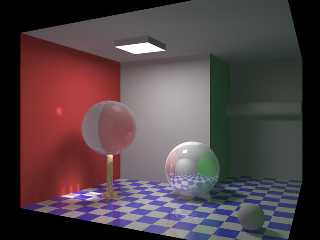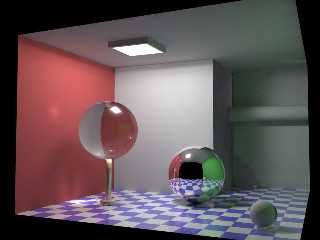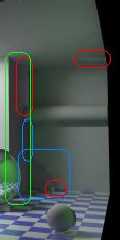 |
 |
|
 |
|
 |
|  |
|  |
|
 |
From: Ari-Matti Leppaenen
Subject: Re: Cornell's box; MegaPOV vs. WinOSi
Date: 31 Aug 2003 10:58:05
Message: <3f520cfd@news.povray.org>
|
|
 |
|  |
|  |
|
 |
This is my try with POV3.5. Radiosity values are saved first from a
diffrent camera position and a super wide FOV to get most of the room
visible and then the final with photons, loadedradiosity values and
no_image for the front and right walls. The lighting is still a bit
darker and material don't look quite the same, but at least now I'm
starting to remember how to use POV.
A-M
Post a reply to this message
Attachments:
Download 'winosi.jpg' (29 KB)
Preview of image 'winosi.jpg'

|
 |
|  |
|  |
|
 |
|
 |
|  |
|  |
|
 |
Nice, but it still lacks something. :o) Anyway, how did you convert the
scene to POV? The WinOSi homepage offers the file in vmd, dxf and rib
format, and I tried at least 6 different converters but none of them worked,
so I had to rewrite the scene in POV myself (based on the vmd file). The
camera orientation and up-vector was about to drive me crazy.
> Radiosity values are saved first from a diffrent camera
> position and a super wide FOV to get most of the room visible
Could you elaborate on that?
You also said, you had a "no light" scenario, but I suppose you did use
light_sources to calc photons, right?
Regards,
Hugo
Post a reply to this message
|
 |
|  |
|  |
|
 |
|
 |
|  |
|  |
|
 |
Hugo Asm wrote:
> Anyway, how did you convert the scene to POV?
I also wrote the scene based on the vmd. The catch is that it's a right
handed system and z-axis points up and not into the screen. Also the
angle has to be a bit larger than 42 degrees.
>>Radiosity values are saved first from a diffrent camera
>>position and a super wide FOV to get most of the room visible
>
> Could you elaborate on that?
The cameras look like this:
#if( save_rad )
camera {
location <0.0, -0.01, 1.25>
look_at <0.13, -1.14, 1.25>
sky <0.00, 0.00, 1.00>
right -(4/3)*x
angle 175.0
}
#else
camera {
location <-1.27, 3.00, 1.25>
look_at <0.33, -0.14, 1.25>
sky <0.00, 0.00, 1.00>
right -(4/3)*x
angle 55.0
}
#end
> You also said, you had a "no light" scenario, but I suppose you did use
> light_sources to calc photons, right?
Yes, this one has a light_source. Earlier this year I tried an ambient
box for the lighting.
A-M
Post a reply to this message
|
 |
|  |
|  |
|
 |
|
 |
|  |
|  |
|
 |
> >Radiosity values are saved first from a diffrent camera
> >position and a super wide FOV to get most of the room visible
That's a clever trick, and I didn't expect it to work! Well, it has some
problems. The attached picture was rendered with a 90 degrees angle for
radiosity (it was too hard to adjust the camera at 175 degrees). I also
rendered radiosity at double resolution but there are definitely some
artifacts left.
> this one has a light_source. Earlier this year I tried an ambient
> box for the lighting.
And you're trying to get rid of the splotches? Well, in the image you just
posted, I think the problem is possibly the same I had: You use several
light sources at the ceiling. The easiest solution is to use only 1 light
source during photon calculation.
Regards,
Hugo
Post a reply to this message
Attachments:
Download 'illum2-d.jpg' (26 KB)
Preview of image 'illum2-d.jpg'

|
 |
|  |
|  |
|
 |
|
 |
|  |
|  |
|
 |
> Too bad no_image means no_radiosity. It would be great to be able to
> hide stuff like walls in this case and they would still affect the
> lighting.
That should be possible with
interior_texture {pigment {transmit 1}}
shouldn't it?
Mark
--
merge{#local i=-11;#while(i<11)#local
i=i+.1;sphere{<i*(i*i*(.05-i*i*(4e-7*i*i+3e-4))-3)10*sin(i)30>.5}#end
pigment{rgbt 1}interior{media{emission x}}hollow}// Mark Weyer
Post a reply to this message
|
 |
|  |
|  |
|
 |
|
 |
|  |
|  |
|
 |
> That should be possible with
> interior_texture {pigment {transmit 1}}
> shouldn't it?
I thought about it, but a quick try didn't work.
Now I might have got it to work!
It slows down rendering I'm afraid, but it works!
Thanks,
Hugo
Post a reply to this message
|
 |
|  |
|  |
|
 |
|
 |
|  |
|  |
|
 |
Hi Hugo,
There are many strange artifacts in your image -- see attached image
(only intended as a 'pointer' to your original post; red: too bright;
blue: too dark; green: gray instead of green). I don't think they are
caused by multiple light sources at the ceiling (or do they vanish
when only one light source is used?)
Sputnik
Post a reply to this message
Attachments:
Download 'illum2-d_detail.jpg' (5 KB)
Preview of image 'illum2-d_detail.jpg'

|
 |
|  |
|  |
|
 |
|
 |
|  |
|  |
|
 |
Sputnik wrote:
> There are many strange artifacts in your image -- see attached image
Thanks. Yes, you're right. These are caused by calculating radiosity in a 90
degrees camera angle, and rendering the final image with a 45 degrees angle.
Higher settings for radiosity would look nicer, but I found another solution
as Mark Weyer pointed me to: interior_texture.
Sputnik wrote:
> I don't think they are caused by multiple light sources at the
> ceiling (or do they vanish when only one light source is used?)
No, multiple light sources at the ceiling makes the photons look bad. Each
of these lights will make a bright photon-spot below the glass sphere, but
at slightly different positions. The result looks splotchy. Using only 1
light gives smooth caustics.
With all these parameters carefully adjusted, the 3 passes takes about 35
minutes to render. That's a lot quicker than joining everything in 1 pass.
WinOSi, on the other hand, need about 8 hours to make a similar, smooth
image (nearly free from noise). I checked it tonight. But there are some
advantages of WinOSi.. In short, it's more accurate.
Regards,
Hugo
Post a reply to this message
|
 |
|  |
|  |
|
 |
|
 |
|  |




![]()